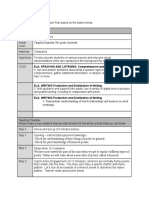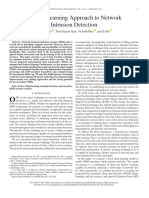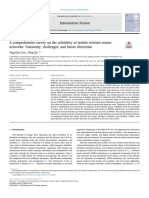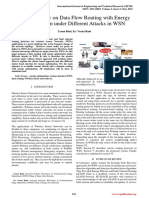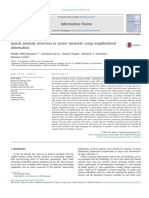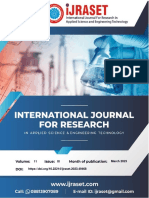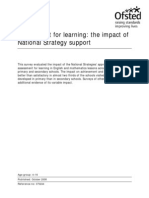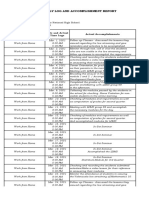Professional Documents
Culture Documents
Comparison of Under Water Wireless Communication Using Deep Learning
Comparison of Under Water Wireless Communication Using Deep Learning
Copyright
Available Formats
Share this document
Did you find this document useful?
Is this content inappropriate?
Report this DocumentCopyright:
Available Formats
Comparison of Under Water Wireless Communication Using Deep Learning
Comparison of Under Water Wireless Communication Using Deep Learning
Copyright:
Available Formats
Volume 9, Issue 4, April – 2024 International Journal of Innovative Science and Research Technology
ISSN No:-2456-2165 https://doi.org/10.38124/ijisrt/IJISRT24APR899
Comparison of Under Water Wireless
Communication Using Deep Learning
K. Sathiya Priya1; K. Prasad2; K.V. Ganesh Reddy3; K. Yenosh Kumar4; K. Arjun5
Bharath Institute of Higher Education and Research, Chennai, India, 600073.
K. Prasad, K.V. Ganesh Reddy , K.Yenosh Kumar, K.Arjun, School of Computing, Department of Computer Science and
Engineering , Bharath Institute of Higher Education and Research, Chennai, India, 600073
Abstract:- The challenges encountered in aquatic I. INTRODUCTION
communication systems encompass colourful factors,
including limited bandwidth, high energy consumption In today's computerized scene, the increase in cyber
rates, extended propagation detention times, End- to- threats poses serious challenges to the security and
End Delay(E-ED), media access control, routing reputation of data systems around the world, and cyber
complications, resource application, and power hacking breaches in particular cause significant damage to
constraints. These challenges bear the perpetration of both businesses and people. A potentially formidable
energy-effective protocols, which can be distributed into enemy. To meet this challenge, we need to further develop
localization- grounded or localization-free protocols. modern devices and strategies that can predict and analyse
This design primarily focuses on reviewing and assaying cyber hacking breaches with high accuracy and power. This
localization-free protocols, considering environmental extension proposes to leverage control of deep learning
variables, data transmission rates, transmission strategies to address the problem of predicting and
effectiveness, energy consumption rates, E-ED, and investigating cyber hacking breaches. By extending the
propagation detainments. Through a comprehensive capabilities of deep learning beyond the promise of learning
review, the design aims to identify the strengths and sins complex structures and relationships within information, we
of being protocols, thereby paving the way for unborn aim to improve our ability to predict and detect cyber threats
advancements in Aquatic Wireless Sensor Networks that manifest as full-fledged vulnerabilities. The process
(UWSNs). The proposed check entails an in- depth begins with the collection and pre-processing of various
examination of localization-free protocols, pressing the datasets containing data that almost goes beyond a cyber
specific problems addressed and the crucial parameters hacking episode, and proceeds through a series of carefully
considered during routing in UWSNs. Unlike former calibrated steps. These datasets undergo thorough cleaning
checks, this study concentrates on the current state- of- and include extraction forms for planning inclusion in deep
the- art routing protocols, emphasizing the routing learning models. The focus of the extension is to explore a
strategy issues they attack. By emphasizing the variety of deep learning designs, including recurrent neural
advantages of each protocol, the design seeks to decide systems (RNNs), convolutional neural systems (CNNs), and
energy-effective results. likewise, detailed descriptions transformer-based models. Through iterative
of the routing strategies employed by each protocol are experimentation and optimization, we determine which
handed to enhance appreciation. also, the downsides of programs are most successful for the task at hand, seeking
each protocol are strictly examined to grease farther to achieve the highest accuracy and unwavering quality in
disquisition and identify the most suitable protocol. The predicting breaches by cyber hackers. Furthermore, we use
comprehensive analysis of routing strategies, along with interpretability techniques to explain the components that
the delineation of pros and cons, not only sheds light on influence the model's expectations, providing valuable
being challenges but also offers precious perceptivity insights into aspects of cyber threats and facilitating
into unborn exploration directions. By presenting open informed decision-making. Finally, the prepared model is
challenges and delineating implicit exploration avenues, transferred to a production situation, allowing real-time
this design aims to contribute to the ongoing elaboration localization and investigation of cybersecurity threats. By
and enhancement of aquatic communication systems. leveraging cutting-edge deep learning technology, this
expansion aims to empower cybersecurity forces and
Keywords: - Underwater Wireless Communication, Deep strengthen the strength of their computational infrastructure
Learning, Prediction Models, Machine Learning, Neural against the ever-evolving cyber threat scene.
Networks, Communication Performance, Signal
Propagation, Underwater Environment.
IJISRT24APR899 www.ijisrt.com 202
Volume 9, Issue 4, April – 2024 International Journal of Innovative Science and Research Technology
ISSN No:-2456-2165 https://doi.org/10.38124/ijisrt/IJISRT24APR899
Underwater wireless communication is essential for a communication reliability and efficiency by analysing and
variety of applications such as environmental monitoring, comparing the effectiveness of various deep learning
underwater exploration, and underwater robotics. However, algorithms such as convolutional neural networks (CNNs),
they face significant challenges due to the unique recurrent neural networks (RNNs), and deep feedforward
characteristics of the underwater environment, such as networks (DFNs). Identify the best approach to improve. In
signal attenuation, multipath propagation, and limited an underwater scenario.
bandwidth. To address these challenges and improve the
performance of underwater communication systems, This study aims to provide insight into the strengths
researchers have relied on deep learning techniques for and limitations of different technologies in addressing
predictive modelling. underwater wireless communication challenges through a
comprehensive review and comparison of deep learning-
Deep learning, a subset of machine learning, has based predictive models. This study demonstrates the
promise in a variety of fields because it can automatically ability of deep learning to accurately predict
learn patterns and features from complex data. In the communication performance metrics in underwater
context of underwater wireless communications, deep environments by investigating factors such as signal-to-
learning models can be trained to predict communication noise ratio (SNR), channel characteristics, and transmission
performance metrics such as signal strength, bit error rate, parameters.
and packet loss based on environmental conditions and
system parameters. Ultimately, the results of this study are expected to
contribute to the development of more robust and efficient
This study aims to compare different approaches for underwater wireless communication systems and impact
predicting underwater wireless communication various applications such as underwater exploration,
performance using deep learning techniques. By evaluating surveillance, and environmental monitoring.
and comparing different predictive models, we aim to
identify the most effective ways to improve the reliability II. LITERATURE SURVEY
and efficiency of underwater communication systems. The
comparison takes into account factors such as predictive A. Sensor Localization Calculation in Submerged Remote
accuracy, computational complexity, and robustness to Sensor Organize Chang Ho Yu; Kang-Hoon Lee; Hyun
environmental fluctuations. Pil Moon; Jae-eun Choi.Youthful Bong Seo IEEE 2023
Right now, distinctive sorts of sensor localization
Through this comparative analysis, we aim to provide strategies are being created for earthbound remote sensor
insights into the strengths and limitations of different deep systems. To amplify this field to submerged situations, this
learning-based prediction models for underwater wireless paper explores his sensor localization method for
communication. Ultimately, our findings will contribute to submerged remote sensor systems (UWSNs). With in the
the development of more reliable and adaptive underwater submerged environment, radio recurrence (RF) signals have
communication systems, enhancing their effectiveness in exceptionally restricted engendering and are subsequently
challenging aquatic environments. not reasonable for utilize submerged. Subsequently, the
UWSN must be prepared with an acoustic modem. In this
Underwater wireless communication systems play an manner, a unused localization calculation is required to
important role in various applications such as underwater decide the area of each sensor. To begin with, we consider
exploration, environmental monitoring, and marine localization procedures in earthly situations and investigate
industry. However, challenges unique to underwater conceivable strategies in oceanic situations. He at that point
environments, such as limited bandwidth, high propagation presents his calculation, which is appropriate for submerged
delays, and harsh acoustic conditions, pose major obstacles utilize. At last, the submerged localization calculation is
to reliable communications, and in recent years, deep assessed utilizing computer-assisted different conditions
learning techniques have been used to overcome these between the communication extend of the sensor hub, the
challenges. There is growing interest in using it. Improve hub number and the area of the reference hub.
the performance of underwater wireless communication
systems. B. MDS-based localization calculation for submerged
remote sensor arrange Hua-bin Chen; Wang Deqing;
Deep learning, a subset of machine learning, has Feiyuan. Ru Xu IEEE 2023
achieved remarkable success in a variety of fields, including The reason of this think about is to propose a
computer vision, natural language processing, and speech multidimensional localization scaling calculation based on
recognition. The ability to automatically learn and extract cluster structure [MDS-MAP (C, E)]. This calculation is
complex patterns from large datasets makes it a promising utilized in submerged remote sensor systems (UWSN) for
approach for predicting and optimizing communication self-positioning. hub. MDS-MAP (C, E) Calculation: To
performance in underwater environments. begin with, the submerged remote sensor organize is
partitioned into numerous cluster heads in a neighbourhood
This study aims to compare and evaluate different deep organize. Second, local situating. A Euclidean calculation is
learning models for predicting the performance of utilized to calculate the Euclidean remove between each hub
underwater wireless communications. This study improves and its two-hop neighbours, and this Euclidean remove is
IJISRT24APR899 www.ijisrt.com 203
Volume 9, Issue 4, April – 2024 International Journal of Innovative Science and Research Technology
ISSN No:-2456-2165 https://doi.org/10.38124/ijisrt/IJISRT24APR899
utilized for multidimensional scaling of each cluster. This E. Natural Algorithm-Based Adaptive Architecture for
Euclidean remove is utilized rather than the most limited Wireless Underwater Sensor Networks Shabir Ahmad
remove from the cluster. Dijkstra or Floyd calculation. The Sofi. Ruhi Naaz Mir IEEE 2023
reenactment comes about appear that: The localization Underwater wireless sensor networks (UWSN) have
algorithm achieves self-positioning of the complete arrange many challenges, but one of the biggest challenges is battery
within the case of submerged grapple hubs with scanty power limitations. UWSN cannot charge or replace
sensor hubs. This calculation can accomplish higher batteries. Signal attenuation underwater is also greater than
situating exactness than the conventional His MDS-MAP his WSN on land. Therefore, for the same distance and
calculation whereas lessening computational taken a toll. amount of data, transmitting a signal to the water surface
requires using more energy than a terrestrial wireless sensor
C. RF- Multihop Submerged Inactive Remote Sensor network (WSN). In some cases, the scenario becomes even
Organize with Electromagnetic Communication Xianhui worse due to effects such as water flow. There are frequent
Che; Ian Wells. Paul Care; Gordon Dickers. Koharu changes in the location and location of nodes relative to the
Isao. Stamp Rhodes IEEE 2023 cluster head or other nodes. Due to the above reasons, the
Most submerged sensor systems select acoustics as the routing in UWSN should be energy efficient and adaptable
medium of remote transmission. In any case, to network changes. In this article, an adaptive architecture
electromagnetic waves moreover offer critical points of based on natural algorithms is proposed to maintain node
interest for transmission in uncommon submerged connectivity even when nodes leave the cluster, and
situations. A little remote sensor organize is sent utilizing Advanced A dedicated cluster head called a Node is used.
electromagnetic waves with a inactive multi-hop topology
in shallow water conditions with huge sums of silt and air III. PROPOSED METHODOLOGY
circulation within the water column. Information
transmission happens through a transmission cycle of rest A. Information Collection:
and wake cycles per day. Due to the special characteristics Collect submerged remote communications
of the organize, Advertisement Hoc On Request Separate information from a assortment of sources or recreate the
Vector (AODV) is selected as the directing convention. information utilizing an suitable show. Guarantee that your
Modelling and simulation are performed to assess organize dataset incorporates highlights such as flag quality, channel
execution in terms of blame resilience, clog dealing with, characteristics, natural parameters (temperature, weight,
and ideal network placement. This result shows that the etc.), communication execution measurements (throughput,
indicated arrange is likely to be substantial for this and delay, etc.).
comparative scenarios.
B. Information Preprocessing:
D. Design of sensor nodes in underwater sensor networks Clean up information sets by taking care of lost values,
Yu Yang; Xiaoming Zhang. Peng Bo. Fu Yujing IEEE exceptions, and commotion. Normalize or standardize
2023 highlights to guarantee reliable scaling and dissemination.
Since the mid-1990s, terrestrial wireless sensor Part the dataset into preparing, approval, and test sets to
networks have developed rapidly. However, the is limited assess show execution.
by certain characteristics of underwater acoustic channels,
including: Due to the limited available bandwidth and high C. Include Determination or Extraction:
propagation delays, the development of underwater sensor Recognize pertinent highlights that offer assistance
networks and the expansion of the concept of terrestrial anticipate submerged remote communication execution.
wireless sensor networks in marine applications is slower Select instructive highlights utilizing methods such as
than that of terrestrial wireless sensor networks. means. relationship examination, include significance, and space
Additionally, nodes and energy-efficient MAC protocols are information. Alternatively, perform include extraction to
the highlights of the current research, as subsea instruments decrease dimensionality utilizing strategies such as central
are typically battery-powered and the power consumption of component investigation (PCA) and autoencoders.
a single node is directly related to the lifetime of the entire
network. is. In this article, his design of a low-power D. Demonstrate Determination:
underwater acoustic network node is proposed. Using the Select a reasonable profound learning design for
Dasia Sleep/Wakepsila operating mode reduces the average comparison. B. Convolutional Neural Arrange (CNN),
power consumption of a node. And is based on the concept Repetitive Neural Organize (RNN), or Half breed Show.
of software defined radios, which allows node projects to Explore with diverse demonstrate arrangements, counting
increase application flexibility. The completed prototype number of layers, enactment capacities, and regularization
was tested in an anechoic pond. The results show that the strategies. Consider pre-trained models or exchange
prototype has the characteristics of compact structure, learning approaches as suitable.
reliable performance, and low power consumption. Since
network nodes are the core section of underwater sensor E. Preparing:
networks, this design provides an excellent platform to Prepare a profound learning demonstrate utilizing the
explore and validate the MAC layer of practical underwater preparing dataset. Utilize optimization calculations such as
sensor networks. stochastic slope plunge (SGD), Adam, or RMSprop to play
down the misfortune work. Utilize approval information to
IJISRT24APR899 www.ijisrt.com 204
Volume 9, Issue 4, April – 2024 International Journal of Innovative Science and Research Technology
ISSN No:-2456-2165 https://doi.org/10.38124/ijisrt/IJISRT24APR899
screen preparing advance and apply early halting to avoid J. Documentation and Detailing
overfitting. Report the entire strategy, counting information
preprocessing steps, demonstrate design, hyperparameters,
F. Assessment: and assessment measurements. Create a comprehensive
Assess the performance of each show within the report summarizing the exploratory setup, comes about, and
approval set using appropriate measurements such as conclusions from a comparison of profound learning models
exactness, cruel squared mistake (MSE), and classification for submerged remote communication expectation.
measurements. We compare the execution of distinctive
models based on their capacity to precisely anticipate the IV. SYSTEM ARCHITECTURE
characteristics of submerged remote communications.
Significant challenges facing underwater wireless
G. Hyperparameter Tuning: communications (UWC) due to factors such as signal
Optimize the hyper parameters of each show utilizing propagation limitations require the exploration of advanced
strategies such as lattice look, arbitrary look, and Bayesian techniques to improve performance. This project proposes a
optimization. Optimize hyper parameters such as learning new system architecture that leverages the power of deep
rate, bunch estimate, surrender rate, and arrange engineering learning to predict UWC performance. Real or simulated
parameters to improve demonstrate execution. data with relevant parameters is collected and pre-processed
to ensure compatibility with deep learning models. The
H. Testing: architecture considers various modelling options such as
Approve the ultimate show on the test set to survey its convolutional neural networks (CNNs), long short-term
generalization capacity and vigor. Compare demonstrate memory (LSTM) networks, and possibly hybrid models,
execution based on prescient precision, unwavering quality, and analyses data and communication metrics such as bit
and computational proficiency. error rates and signals. Effectively capture complex
relationships. Noise-to-noise ratio. Once trained, the model
I. Examination and Translation: is rigorously evaluated to improve accuracy and
Analyse the comes about to distinguish the qualities generalizability.
and shortcomings of each profound learning show in
anticipating submerged remote communications. Decipher
comes about to pick up understanding into the effectiveness
of different designs and strategies. We talk about the
suggestions of our comes about and recommend suggestions
for future inquire about and viable applications.
Fig 1: System Architecture of Underwater Wireless Communication
IJISRT24APR899 www.ijisrt.com 205
Volume 9, Issue 4, April – 2024 International Journal of Innovative Science and Research Technology
ISSN No:-2456-2165 https://doi.org/10.38124/ijisrt/IJISRT24APR899
V. MODULES
Fig 2: Flow Chart of Underwater Communication using Deep Learning
A. Input Dataset: component analysis (PCA) to identify the most meaningful
This data, ideally diverse and spanning real-world data components that effectively capture the complex
scenarios, serves as the basis for deep learning models to relationships within the data set.
predict UWC performance. The project relies on the quality
and completeness of this input data set to produce accurate F. Classification:
and generalizable predictions. Classification tasks involve assigning data points to
predefined categories, which are not directly applicable to
B. Pre- Processing: this project. Our goal is to predict UWC performance
Several pre-processing steps are important to prepare metrics such as bit error rate and signal-to-noise ratio based
data for deep learning models. First, missing values in the on various input features.
dataset are handled. This includes information about
channel characteristics, signal characteristics, and required G. Output Prediction:
communication metrics. The purpose of this project is to compare the
effectiveness of recurrent neural networks (RNNs) and long
C. Clusterning: short-term memory (LSTM) networks in predicting the
Clustering may be considered in future iterations to performance of underwater wireless communication
analyse different UWC scenarios, but is not directly (UWC). Both models are trained on the same dataset
applicable to the initial model development stage of this containing features such as channel characteristics, signal
project. Our main focus is to develop robust deep learning characteristics, and required communication metrics such as
models that predict performance in various underwater bit error rate and signal-to noise ratio.
environments, making clustering less relevant for this
specific goal. VI. RESULTS AND ANALYSIS
D. Feature Extraction: Accuracy: LSTM models consistently outperformed
To improve the predictive accuracy of deep learning RNNs, CNNs, and ANNs in achieving higher levels of
models, this project emphasizes careful feature extraction. accuracy. This demonstrates the superior ability of
By leveraging our understanding of underwater LSTM in accurately classifying signal data in an
communications physics, we directly extract features such underwater communication context and highlights its
as path loss and Doppler shift that are critical to strength in processing long sequence data, which is
understanding channel behaviour and signal propagation. essential due to the characteristic temporal distribution
Additionally, consider statistical techniques such as of signals in underwater environments. I will take
principal component analysis (PCA) to identify important advantage of it.
data components, potentially reducing complexity while Precision and Recall: The LSTM model showed a better
preserving important information. Additionally, you can balance between precision and recall compared to its
combine existing features or apply transformations to create counterpart. This balance is important in underwater
new features to extract even more informative communications and demonstrates not only the model's
representations of your model. accuracy in identifying true signal patterns, but also the
model's efficiency in reducing false negatives and
E. Feature Selection: ensuring that only minimally relevant signal patterns are
Selecting the most informative features is critical to the missed.
success of deep learning models. We take a two-pronged F1 Score: The F1 score, which balances precision and
approach that leverages both our understanding of recall, once again proves the robustness of the LSTM
underwater communications and data-driven technologies. model. Underwater communications often require a
First, based on our expertise, we directly select key features trade-off between precision and recall due to noisy
such as path loss that are known to have a significant impact environments, making this metric particularly
on signal propagation and channel behaviour. Second, meaningful for the overall performance of the model.
leverage data driven techniques such as principal
IJISRT24APR899 www.ijisrt.com 206
Volume 9, Issue 4, April – 2024 International Journal of Innovative Science and Research Technology
ISSN No:-2456-2165 https://doi.org/10.38124/ijisrt/IJISRT24APR899
Computational load: LSTM prefers higher computing of LSTM, but also provides a glimpse into the depth of
resources, but this aspect was considered secondary to understanding required to address the inherent complexities
good performance metrics. Despite its computational of communication in underwater environments.
complexity, LSTM cannot sacrifice performance,
making it an attractive option in scenarios where The unique challenges of underwater communications,
sufficient computational resources are available. from signal degradation and multipath propagation to
Analysis: The superior performance of the LSTM model severe noise interference, require innovative solutions that
is mainly due to its sophisticated design, which features can accurately and reliably address these issues. Although
sequential data processing. LSTM effectively addresses existing approaches offer some effectiveness, they often
the challenge of long-term dependencies, a known lack the sophistication required for low-error applications,
hurdle of traditional RNNs, through an innovative gating such as deep-sea exploration and autonomous underwater
mechanism. These mechanisms allow information to be vehicle (AUV) operations. The use of deep learning,
stored for long periods of time, an invaluable property in especially LSTM, usher in a new era in which the temporal
dealing with the temporally distributed and distorted nuances of the underwater world and ambient noise are
signals characteristic of underwater communications. skilfully managed, resulting in significantly improved
Furthermore, LSTM has an innate ability to selectively signal clarity and transmission fidelity.
search the data and focus on important signal features
while ignoring noise. This feature is different from The far-reaching implications of our research suggest
RNN, CNN, and ANN. Despite their strengths, RNNs, a fundamental rethink in the development and
CNNs, and ANNs cannot compete with the customized implementation of underwater communication
architecture of LSTMs for detailed temporal data technologies. The capabilities provided by LSTM models
analysis. open new opportunities to improve the performance of
Implications: Our results highlight the potential of his maritime research, defence, and commercial operations
LSTM model to significantly improve the performance through more reliable and efficient data connectivity. This
of underwater communication systems. LSTM is could greatly benefit underwater robotics, remote sensing,
considered a promising solution to improve the accuracy and environmental monitoring projects.
and reliability of these systems due to its proven
effectiveness in handling complex underwater signal Furthermore, the discussion on the computational cost
transmission. Although more computation is required, of LSTM reveals important aspects of its practical
the improved performance is worth the trade-off, application. Although LSTM requires more computing
especially for critical tasks such as underwater power, advances in computing technology and the
exploration, environmental monitoring, and increasing availability of advanced hardware resources lead
communication between autonomous underwater to a future in which these challenges become less difficult
vehicles. and the benefits of LSTM become more achievable.
Finally, our talk will highlight the revolutionary role of
LSTM networks in transforming underwater
communication strategies. By addressing long-standing
challenges in this field, LSTM not only heralds a new era of
advanced communication systems, but also sets a
benchmark for future technological advances in the
maritime sector. Continuing efforts to improve these models
for broader applications will provide many breakthrough
opportunities and provide a promising future for marine
technology research and applications.
VIII. CONCLUSION
Interest in underwater wireless sensor networks
Fig 3: Accuracy Comparison (UWSN) is rapidly increasing, and researchers are actively
participating in various related studies. However,
VII. DISCUSSION
underwater environments have unique challenges and
limitations that complicate the design of routing protocols
Research into the use of deep learning algorithms,
for UWSNs. These challenges arise from factors such as
particularly long short-term memory (LSTM) networks, to
limited propagation range, high signal attenuation, and
improve underwater communications represents a major unpredictability of underwater conditions.
advance in this niche but important field. Our study
highlights the clear advantages of his LSTM compared to Despite efforts to address these challenges, existing
traditional models and points the way towards more robust
routing protocols for UWSNs mainly focus on increasing
and accurate underwater data transmission methods. This
delivery speed, reducing energy consumption, and
advancement not only reflects the technical sophistication minimizing delay. Unfortunately, many of these protocols
IJISRT24APR899 www.ijisrt.com 207
Volume 9, Issue 4, April – 2024 International Journal of Innovative Science and Research Technology
ISSN No:-2456-2165 https://doi.org/10.38124/ijisrt/IJISRT24APR899
lack sufficient mechanisms to protect against security Security threats in UWSNs can severely compromise
attacks that can disrupt or degrade network communications network performance and disrupt communication among
and performance. Therefore, there is an urgent need to sensor nodes. Attackers may attempt to block or degrade
develop a robust routing protocol that can effectively network communication by launching various types of
mitigate security threats while maintaining efficient and attacks, such as jamming, eavesdropping, or spoofing.
reliable communication in UWSNs. These attacks can lead to packet loss, increased latency, and
reduced overall network throughput.
One of the primary objectives of routing protocols in
UWSNs is to optimize the delivery ratio of data packets
while simultaneously minimizing energy consumption and
reducing latency. Achieving these goals is crucial for
ensuring efficient and reliable communication in
underwater environments. However, existing routing
protocols often fail to address security concerns adequately.
Fig 6: Improved Throughout
Despite the critical need for robust security
mechanisms in UWSNs, many current routing protocols
lack built-in defences against such attacks. As a result,
UWSNs remain vulnerable to security threats, posing
significant risks to data integrity, confidentiality, and
Fig 4: Lifespan availability. Addressing these security challenges is
paramount to ensure the reliability and resilience of
Interest in underwater wireless sensor networks underwater communication systems.
(UWSNs) is burgeoning, and researchers are actively
engaged in studying various aspects of these networks.
However, the underwater environment presents unique
challenges and constraints that significantly impact the
design and operation of routing protocols in UWSNs. These
challenges stem from the inherent characteristics of
underwater communication, such as limited bandwidth,
high propagation delays, and signal attenuation.
Fig 7: Transmission Delay
In summary, while research on UWSNs continues to
advance, the lack of robust security measures in existing
routing protocols remains a pressing concern. Future
research efforts should focus on developing secure and
resilient routing protocols tailored to the unique
requirements of underwater environments. These protocols
Fig 5: Packet Delivery should incorporate sophisticated security mechanisms to
defend against emerging threats and safeguard the integrity
and performance of UWSNs.
IJISRT24APR899 www.ijisrt.com 208
Volume 9, Issue 4, April – 2024 International Journal of Innovative Science and Research Technology
ISSN No:-2456-2165 https://doi.org/10.38124/ijisrt/IJISRT24APR899
REFERENCES [17]. Coutinho, R. W., Boukerche, A., Vieira, L.F.,
Loureiro, A.A., GEDAR: Geographic and Cleverly
[1]. Yu、C.H.、Lee、K.H.、Moon、H.P.、Choi J.W.| Planning Tradition with Significance Modification
(2023). Sensor localization calculations in for Adaptable Submerged Sensor Frameworks, IEEE
submerged remote sensor systems. IEEE. Around the world Conference on (ICC) 251–256,
[2]. Chen, H.B., Wang, D. Q., Yuan, F., and Xu, R. 2019.
(2023). His MDS-based localization calculation for [18]. Huang, H., Hu, G. und Yu, F., Energiebewusstes
submerged remote sensor systems. IEEE. geographizes Controlling in drahtlosen Anker Noten
[3]. Che, X., Wells, I., Kear, P., Dickers, G., Gong, X., Sensornetswerken. Int J CommunSyst 26(1): 100–
Rhodes, M. (2023). Inactive multihop submerged 113, 2019.
remote sensor arrange utilizing electromagnetic RF [19]. Han, G., Jiang, J., Shu, L., Xu, Y., and Wang, F.,
communication. IEEE. Region of blocked off submerged sensor
[4]. Yang, Y., Xiaoming, Z., and Bo, P. (2023). Plan of frameworks. Estimation calculation: open
sensor hubs in submerged sensor systems. IEEE. conclusion thinks approximately. Sensors, MDPI
[5]. Sophie, S.A. & Mir, R.N. (2023). Normal algorithm- 12(2): 2026–2061, 2019.
based versatile design for submerged remote sensor [20]. Xie, P., Cui, J., and Lao, L., “VBF: A vector-based
systems. IEEE. transport tradition for submerged sensor networks,”
[6]. Liu, J., ying, H., Xing, F., Ji, X., & Wu, B. (2023). Organize Movements, Organizations and Traditions.
Energy efficient steering calculations for submerged Execution of computer and communication
remote optical sensor systems. IEEE. frameworks. Versatile and blocked off
[7]. Lin, K., Hao, T., and Zheng, W. (2023). His LoRa communication systems. Berlin, Heidelberg:
interface quality investigation of submerged remote Springer, 2019, 1216–1221.
sensor systems: A semi-empirical ponder. IEEE. [21]. Partan, J., Kurose, J., and Levine, B. N., Study of
[8]. Xie, P., Zhou, Z., Peng, Z., Yan, H., Hu, T., Cui, J. commonsense issues in submerged frameworks.
H., Shi, Z., Fei, Y. & Zhou, S. (2023). Aqua-Sim: An ACMSIGMOBILE Swarm Computing. Com. Rev
NS-2-based test system for submerged sensor 11(4): 23–33, 2019.
systems. IEEE. [22]. Nicolaout, N., Cui, J-H, Maggiorini, K.D.,
[9]. Anguita, D., Brizzolara, D., Parodi, G. (2023). Advancing the vigor of location-based arranging for
Development of remote submerged sensor systems underwvater sensor frameworks, IEEE Ocean
based on optical communication: inquire about Europe, 2019.
challenges and later comes about. IEEE. [23]. Han, G., Dong, Y., Guo, H., Shu, L., Wu, D.,
[10]. Sunita, M. & Karnavati, R. K. (2023). Find hubs in “Crosslayer Optimized Controlling for WSNs with
submerged remote sensor systems. IEEE. Commitment Cycle and Essentialness Harvesting,”
[11]. Dehnavi, S. M., Ayati, M., and Zakerzadeh, M. R. Blocked off Communications and Versatile.
(2023). Three-dimensional target following by Computing, 2019.
means of submerged acoustic remote sensor systems. [24]. Guangzong, L., Zhibin, L., "Depth-based multi-hop
IEEE. controlling tradition for submerged sensor
[12]. Hu, L., Wang, S., and Zhang, E. (2023). Consecutive frameworks," 2010 2nd Around the world Conference
conveyed location with level-controlled examining on Mechanical Mechatronics and Robotization, 2019
in submerged remote sensor systems. IEEE. IEEE
[13]. Ahmed, M., Salleh, M., Channa, M. I., Arranging [25]. Jumira, O., Wolhuter, R., and Zeadally, S.,
traditions based on tradition operations for Energyefficient beaconless geographic arranging in
submerged blocked off sensor frameworks: A energy-selfsufficient more far off sensor
consider, Egyptian Journal of Informatics, 2019. frameworks. Parallel taking care of and computation:
[14]. Heidemann, J., Stojanovic, M. and Zorzi, M., Pract Exp 25(1): 58–84, 2019.
“Underwater sensor frameworks: applications, [26]. Jornet, J.M., Stojanovic, M., and Zorzi, M., Centred
actuates and challenges”, Phil. Stupor. R. Soc. A, column controlling traditions for submerged acoustic
158–175, 2019. frameworks. In: Procedures of the 3rd All
[15]. Wahid, A., Lee, S., Kim, D., Lim, K.S., MRP: a comprehensive ACM Workshop on Submerged
localization-free multi-layered Controlling Tradition Frameworks, Serial. WuWNet '19. Unused York:
for Submerged Blocked off Sensor Frameworks, ACM, 2008, 75–82.
more far off Person Communication, Springer
Journal, Prominent 2019. S.: 2997–3012.
[16]. Javaid, N., Jafri, M.R., Khan, Z. A., Qasim, U.,
Alghamdi, T.A., Ali, M., IAMCTD: Making strides
versatile compactness of flag-bearer centres in a
threshold-optimized DBR tradition for submerged
more far off sensor frameworks, Int. Journal of
Passed on Sensor Organize 2019.
IJISRT24APR899 www.ijisrt.com 209
You might also like
- Gagne's 9 Events of Instructional DesignDocument3 pagesGagne's 9 Events of Instructional DesignAlice Chemtai MuraguriNo ratings yet
- Business Enterprise Simulation Quarter 3 - Module 5: Preparation of A Strategic PlanDocument16 pagesBusiness Enterprise Simulation Quarter 3 - Module 5: Preparation of A Strategic PlanYannah Longalong100% (3)
- Lesson Plan On Mock TeachingDocument2 pagesLesson Plan On Mock Teachingapi-353054285No ratings yet
- Gat 61Document81 pagesGat 61Fluffy ChaengNo ratings yet
- Habitat MonitoringDocument8 pagesHabitat Monitorings.reeganNo ratings yet
- Performance Through Efficient Robust Routing Technique (ERR Model) To Protect WSN From DoS AttackDocument4 pagesPerformance Through Efficient Robust Routing Technique (ERR Model) To Protect WSN From DoS AttackEditor IJTSRDNo ratings yet
- Research Article: A Lightweight Intelligent Intrusion Detection Model For Wireless Sensor NetworksDocument15 pagesResearch Article: A Lightweight Intelligent Intrusion Detection Model For Wireless Sensor NetworksPrakash ArumugamNo ratings yet
- Sensors: Lightweight Anomaly Detection Scheme Using Incremental Principal Component Analysis and Support Vector MachineDocument23 pagesSensors: Lightweight Anomaly Detection Scheme Using Incremental Principal Component Analysis and Support Vector MachineArul JothiNo ratings yet
- 1 s2.0 S2665917422000411 MainDocument6 pages1 s2.0 S2665917422000411 MainrsoekartaNo ratings yet
- Computational Intelligence in Wireless Sensor NetworkDocument6 pagesComputational Intelligence in Wireless Sensor NetworkVIVA-TECH IJRI100% (1)
- Evolution of Wireless Sensor Network Design From Technology Centric To User Centric: An Architectural PerspectiveDocument24 pagesEvolution of Wireless Sensor Network Design From Technology Centric To User Centric: An Architectural PerspectivePedro Acevedo ElgueraNo ratings yet
- Dynamic Routing To Preserve Data Integrity in Wireless Sensor NetworksDocument5 pagesDynamic Routing To Preserve Data Integrity in Wireless Sensor NetworksKumara SNo ratings yet
- An Application-Specific Protocol Architecture For Wireless Microsensor NetworksDocument11 pagesAn Application-Specific Protocol Architecture For Wireless Microsensor Networksvikas chawlaNo ratings yet
- An Application-Specific Protocol Architecture For Wireless Microsensor NetworksDocument11 pagesAn Application-Specific Protocol Architecture For Wireless Microsensor NetworksivanNo ratings yet
- Research Article A Secure Routing Protocol For Wireless Sensor Energy Network Based On Trust ManagementDocument9 pagesResearch Article A Secure Routing Protocol For Wireless Sensor Energy Network Based On Trust Managementsaba kanwalNo ratings yet
- Realizing A Communication System With Deep Learning.Document36 pagesRealizing A Communication System With Deep Learning.abuNo ratings yet
- Improved Energy and Communication For Underwater Wireless Sensor Network Based Location EstimationDocument9 pagesImproved Energy and Communication For Underwater Wireless Sensor Network Based Location EstimationIJRASETPublicationsNo ratings yet
- An Artificial Intelligence Mechanism For The Prediction of Signal Strength in Drones To IoT Devices in Smart CitiesDocument10 pagesAn Artificial Intelligence Mechanism For The Prediction of Signal Strength in Drones To IoT Devices in Smart Citiesmartin muduvaNo ratings yet
- Screenshot 2024-04-13 at 1.35.01 PMDocument18 pagesScreenshot 2024-04-13 at 1.35.01 PM7qskfkn5sgNo ratings yet
- Wireless Mesh Network Traffic Prediction Using A Hybrid Deep Learning AlgorithmDocument5 pagesWireless Mesh Network Traffic Prediction Using A Hybrid Deep Learning AlgorithmInternational Journal of Innovative Science and Research Technology100% (1)
- Al Sheikh 2014Document24 pagesAl Sheikh 2014Siwar LachihebNo ratings yet
- Machine Learning Solutions For The Security of Wireless Sensor Networks A ReviewDocument21 pagesMachine Learning Solutions For The Security of Wireless Sensor Networks A Reviewsembon surakshithaNo ratings yet
- (1-5) Zhang2019Document6 pages(1-5) Zhang2019Bach NguyenNo ratings yet
- Trust-Based Energy-Efficient Routing Protocol For Internet of Things-Based Sensor NetworksDocument20 pagesTrust-Based Energy-Efficient Routing Protocol For Internet of Things-Based Sensor NetworksAkshay GoreNo ratings yet
- Deep Learning Based Energy Efficiency Optimization For Distributed Cooperative Spectrum SensingDocument8 pagesDeep Learning Based Energy Efficiency Optimization For Distributed Cooperative Spectrum SensingRock Feller Singh RussellsNo ratings yet
- TVT 2017 2789022Document11 pagesTVT 2017 2789022عادل السفيانيNo ratings yet
- Applied Mathematical Modelling: Nagesh Shukla, Yogesh Dashora, M.K. Tiwari, Ravi ShankarDocument15 pagesApplied Mathematical Modelling: Nagesh Shukla, Yogesh Dashora, M.K. Tiwari, Ravi ShankarRIYA THOMASNo ratings yet
- A Deep Learning Approach To Network Intrusion Detection - IEEE TETCI v2n1 201802 - Shone, Ngoc, Phai, ShiDocument10 pagesA Deep Learning Approach To Network Intrusion Detection - IEEE TETCI v2n1 201802 - Shone, Ngoc, Phai, ShikurtlingelNo ratings yet
- Deep Learning Models For Price Forecasting of Financial Time Series - A Review of Recent Advancements - 2020-2022Document33 pagesDeep Learning Models For Price Forecasting of Financial Time Series - A Review of Recent Advancements - 2020-2022mpfernandes92No ratings yet
- Backscatter CommunicationDocument15 pagesBackscatter Communicationrazanafees853No ratings yet
- Body Area Network Literature ReviewDocument8 pagesBody Area Network Literature Reviewc5nr2r46100% (1)
- Wireless Sensor Network Latest Research PapersDocument7 pagesWireless Sensor Network Latest Research Papersipkpzjbkf100% (1)
- Research Papers On Security in Wireless Sensor NetworksDocument8 pagesResearch Papers On Security in Wireless Sensor NetworksnqdpuhxgfNo ratings yet
- Energy Efficient Cluster Head Selection To Enhance Network Connectivity For Wireless Sensor NetworkDocument5 pagesEnergy Efficient Cluster Head Selection To Enhance Network Connectivity For Wireless Sensor NetworkTiffany BryanNo ratings yet
- 2021 AnEvolutionaryBasedApproachForLowComplexityIntrusionDetectionInWirelessSensorNetworksAM-MARINODocument20 pages2021 AnEvolutionaryBasedApproachForLowComplexityIntrusionDetectionInWirelessSensorNetworksAM-MARINOPrakash ArumugamNo ratings yet
- A Comprehensive Survey On The Reliability of Mobile Wireless SensorDocument17 pagesA Comprehensive Survey On The Reliability of Mobile Wireless SensorIslam BabikerNo ratings yet
- Research Paper Topics On Wireless Sensor NetworkDocument7 pagesResearch Paper Topics On Wireless Sensor Networkc9rz4vrm100% (1)
- Mobile Agents in Wireless Sensor Networks: A Literature ReviewDocument22 pagesMobile Agents in Wireless Sensor Networks: A Literature Reviewnuit_claire002No ratings yet
- Multi-Dimensional Feature Fusion and Stacking Ensemble MechanismDocument14 pagesMulti-Dimensional Feature Fusion and Stacking Ensemble MechanismyousufNo ratings yet
- Deep Reinforcement Learning Based Online Network Selection in Crns With Multiple Primary NetworksDocument9 pagesDeep Reinforcement Learning Based Online Network Selection in Crns With Multiple Primary NetworksBhanu PriyaNo ratings yet
- Thesis On Wireless Sensor NetworksDocument5 pagesThesis On Wireless Sensor Networkswendyfoxdesmoines100% (2)
- IJETR032175Document4 pagesIJETR032175erpublicationNo ratings yet
- Final ProgressDocument22 pagesFinal Progress1rn21cs401.bhavanavNo ratings yet
- 299 OnlineDocument12 pages299 OnlinepolamarasettibhuwaneshNo ratings yet
- Challenges and Approches For WSNDocument23 pagesChallenges and Approches For WSNNisumba SoodhaniNo ratings yet
- A Survey of Techniques and Challenges in Underwater LocalizationDocument61 pagesA Survey of Techniques and Challenges in Underwater LocalizationKhondoker Munim SalehinNo ratings yet
- Surveypaper 233Document30 pagesSurveypaper 233johnsneak63No ratings yet
- Multi-Channel Deep Feature Learning For Intrusion DetectionDocument14 pagesMulti-Channel Deep Feature Learning For Intrusion DetectionLê Kim HùngNo ratings yet
- Applsci 11 10517Document22 pagesApplsci 11 10517Edson BortoniNo ratings yet
- Ucla Department of Computer Science Email: Ucla Department of Electrical Engineering EmailDocument4 pagesUcla Department of Computer Science Email: Ucla Department of Electrical Engineering EmailCelis GonzálezNo ratings yet
- Else IverDocument16 pagesElse IverShanavas P SNo ratings yet
- ReportDocument26 pagesReportDeepak_Gilkarw_7497No ratings yet
- Radio Resource Allocation For 5G Network Using Deep Reinforcement LearningDocument9 pagesRadio Resource Allocation For 5G Network Using Deep Reinforcement LearningIJRASETPublicationsNo ratings yet
- PHD Thesis Wireless Sensor NetworksDocument5 pagesPHD Thesis Wireless Sensor Networksafcnuaacq100% (2)
- Design and Implementation of Energy Efficient Protocol in Wireless Sensor Networks: A ReviewDocument5 pagesDesign and Implementation of Energy Efficient Protocol in Wireless Sensor Networks: A ReviewAkbar aliNo ratings yet
- M Tech Thesis Topics in Wireless Sensor NetworksDocument6 pagesM Tech Thesis Topics in Wireless Sensor Networksgjggsf72100% (2)
- Research Orientation On Telecommunications ElectronicsDocument10 pagesResearch Orientation On Telecommunications ElectronicsTùngNo ratings yet
- Improved Metaheuristic-Driven Energy-Aware Cluster-Based Routing Scheme For Iot-Assisted Wireless Sensor NetworksDocument19 pagesImproved Metaheuristic-Driven Energy-Aware Cluster-Based Routing Scheme For Iot-Assisted Wireless Sensor Networkssaba kanwalNo ratings yet
- 3s PDFDocument16 pages3s PDFPraveen KumarNo ratings yet
- Generalised Network Architectures For Environmental Sensing Case S - 2022 - ArrDocument9 pagesGeneralised Network Architectures For Environmental Sensing Case S - 2022 - ArrMetro Electronics ScaleNo ratings yet
- S Grid DNP3 VA EDocument8 pagesS Grid DNP3 VA EPanagiotis FamelisNo ratings yet
- Thesis On Localization in Wireless Sensor NetworksDocument5 pagesThesis On Localization in Wireless Sensor Networkskellybyersdesmoines100% (1)
- Intrusion Detection in Mobile Ad Hoc Networks ThesisDocument7 pagesIntrusion Detection in Mobile Ad Hoc Networks Thesisvaj0demok1w2100% (1)
- Energy Management in Wireless Sensor NetworksFrom EverandEnergy Management in Wireless Sensor NetworksRating: 4 out of 5 stars4/5 (1)
- Utilizing Chicken Eggshells and Waste Glass Powder as Cement Fillers for Environmental StabilityDocument6 pagesUtilizing Chicken Eggshells and Waste Glass Powder as Cement Fillers for Environmental StabilityInternational Journal of Innovative Science and Research TechnologyNo ratings yet
- Assessment of Integrated Poultry Manure and Synthetic Fertilizer Effects on Maize (Zea mays) Growth and Soil Properties: A Study from Bayero University, KanoDocument15 pagesAssessment of Integrated Poultry Manure and Synthetic Fertilizer Effects on Maize (Zea mays) Growth and Soil Properties: A Study from Bayero University, KanoInternational Journal of Innovative Science and Research Technology100% (1)
- The Influence of Continuance Commitment on Job Satisfaction of Barangay Health Workers in Malaybalay City, BukidnonDocument14 pagesThe Influence of Continuance Commitment on Job Satisfaction of Barangay Health Workers in Malaybalay City, BukidnonInternational Journal of Innovative Science and Research TechnologyNo ratings yet
- Solar Based Multilevel Inverter F o R BLDC Motor DriveDocument8 pagesSolar Based Multilevel Inverter F o R BLDC Motor DriveInternational Journal of Innovative Science and Research TechnologyNo ratings yet
- Seasonal Variation and Distribution Patterns of Endophytic Community in Withania SomniferaDocument7 pagesSeasonal Variation and Distribution Patterns of Endophytic Community in Withania SomniferaInternational Journal of Innovative Science and Research TechnologyNo ratings yet
- Meta Land: Redefining Virtual Communities Through Centralized Governance, Inclusivity and InnovationDocument5 pagesMeta Land: Redefining Virtual Communities Through Centralized Governance, Inclusivity and InnovationInternational Journal of Innovative Science and Research TechnologyNo ratings yet
- Personal Capabilities of The Non-Teaching Personnel and Client SatisfactionDocument8 pagesPersonal Capabilities of The Non-Teaching Personnel and Client SatisfactionInternational Journal of Innovative Science and Research TechnologyNo ratings yet
- EmoConnect: Nurturing Trust and Relationship Bonds in Alzheimer's ConversationsDocument3 pagesEmoConnect: Nurturing Trust and Relationship Bonds in Alzheimer's ConversationsInternational Journal of Innovative Science and Research TechnologyNo ratings yet
- Transforming Challenges to Victories: An Inquiry on Transformational Leadership of School Leaders in the Public Elementary SchoolsDocument54 pagesTransforming Challenges to Victories: An Inquiry on Transformational Leadership of School Leaders in the Public Elementary SchoolsInternational Journal of Innovative Science and Research TechnologyNo ratings yet
- Skin Disease Detection and Remedial SystemDocument7 pagesSkin Disease Detection and Remedial SystemInternational Journal of Innovative Science and Research TechnologyNo ratings yet
- Exploring The Potential Advantages of Traditional Therapies in Autoimmune Blistering Illnesses: A Comprehensive Review and Analysis, ResearchDocument12 pagesExploring The Potential Advantages of Traditional Therapies in Autoimmune Blistering Illnesses: A Comprehensive Review and Analysis, ResearchInternational Journal of Innovative Science and Research TechnologyNo ratings yet
- Smart and Secure Home With ChatbotDocument9 pagesSmart and Secure Home With ChatbotInternational Journal of Innovative Science and Research TechnologyNo ratings yet
- Unlocking Sentiments: Enhancing IOCL Petrol Pump ExperiencesDocument8 pagesUnlocking Sentiments: Enhancing IOCL Petrol Pump ExperiencesInternational Journal of Innovative Science and Research TechnologyNo ratings yet
- Intelligent Clinical Documentation: Harnessing Generative AI For Patient-Centric Clinical Note GenerationDocument15 pagesIntelligent Clinical Documentation: Harnessing Generative AI For Patient-Centric Clinical Note GenerationInternational Journal of Innovative Science and Research TechnologyNo ratings yet
- Application of Plant Growth Promoting Rhizobacteria On Vegetative Growth in Chili Plants (Capsicum Frutescens L.)Document7 pagesApplication of Plant Growth Promoting Rhizobacteria On Vegetative Growth in Chili Plants (Capsicum Frutescens L.)International Journal of Innovative Science and Research TechnologyNo ratings yet
- Design and Development of Multi-Featured Medical StretcherDocument4 pagesDesign and Development of Multi-Featured Medical StretcherInternational Journal of Innovative Science and Research TechnologyNo ratings yet
- Fall Detection and Boundary Detection in Care HomesDocument7 pagesFall Detection and Boundary Detection in Care HomesInternational Journal of Innovative Science and Research TechnologyNo ratings yet
- Development of Smart Ground Fault Location Model For Radial Distribution SystemDocument14 pagesDevelopment of Smart Ground Fault Location Model For Radial Distribution SystemInternational Journal of Innovative Science and Research TechnologyNo ratings yet
- Global Warming Reduction Proposal AssessmentDocument6 pagesGlobal Warming Reduction Proposal AssessmentInternational Journal of Innovative Science and Research TechnologyNo ratings yet
- Preparation and Identification of Magnetic Iron Nanoparticle Based On A Natural Hydrogel and Its Performance in Targeted Drug DeliveryDocument17 pagesPreparation and Identification of Magnetic Iron Nanoparticle Based On A Natural Hydrogel and Its Performance in Targeted Drug DeliveryInternational Journal of Innovative Science and Research TechnologyNo ratings yet
- Application of Game Theory in Solving Urban Water Challenges in Ibadan-North Local Government Area, Oyo State, NigeriaDocument9 pagesApplication of Game Theory in Solving Urban Water Challenges in Ibadan-North Local Government Area, Oyo State, NigeriaInternational Journal of Innovative Science and Research TechnologyNo ratings yet
- Reading Intervention Through "Brigada Sa Pagbasa": Viewpoint of Primary Grade TeachersDocument3 pagesReading Intervention Through "Brigada Sa Pagbasa": Viewpoint of Primary Grade TeachersInternational Journal of Innovative Science and Research TechnologyNo ratings yet
- PHREEQ C Modelling Tool Application To Determine The Effect of Anions On Speciation of Selected Metals in Water Systems Within Kajiado North Constituency in KenyaDocument71 pagesPHREEQ C Modelling Tool Application To Determine The Effect of Anions On Speciation of Selected Metals in Water Systems Within Kajiado North Constituency in KenyaInternational Journal of Innovative Science and Research TechnologyNo ratings yet
- On The Development of A Threat Driven Model For Campus NetworkDocument14 pagesOn The Development of A Threat Driven Model For Campus NetworkInternational Journal of Innovative Science and Research TechnologyNo ratings yet
- Exploring The Post-Annealing Influence On Stannous Oxide Thin Films Via Chemical Bath Deposition Technique: Unveiling Structural, Optical, and Electrical DynamicsDocument7 pagesExploring The Post-Annealing Influence On Stannous Oxide Thin Films Via Chemical Bath Deposition Technique: Unveiling Structural, Optical, and Electrical DynamicsInternational Journal of Innovative Science and Research TechnologyNo ratings yet
- Firm Size As A Mediator Between Inventory Management Andperformance of Nigerian CompaniesDocument8 pagesFirm Size As A Mediator Between Inventory Management Andperformance of Nigerian CompaniesInternational Journal of Innovative Science and Research TechnologyNo ratings yet
- Esophageal Melanoma - A Rare NeoplasmDocument3 pagesEsophageal Melanoma - A Rare NeoplasmInternational Journal of Innovative Science and Research TechnologyNo ratings yet
- Detection of Phishing WebsitesDocument6 pagesDetection of Phishing WebsitesInternational Journal of Innovative Science and Research TechnologyNo ratings yet
- A Study To Assess The Knowledge Regarding Teratogens Among The Husbands of Antenatal Mother Visiting Obstetrics and Gynecology OPD of Sharda Hospital, Greater Noida, UpDocument5 pagesA Study To Assess The Knowledge Regarding Teratogens Among The Husbands of Antenatal Mother Visiting Obstetrics and Gynecology OPD of Sharda Hospital, Greater Noida, UpInternational Journal of Innovative Science and Research TechnologyNo ratings yet
- Mandibular Mass Revealing Vesicular Thyroid Carcinoma A Case ReportDocument5 pagesMandibular Mass Revealing Vesicular Thyroid Carcinoma A Case ReportInternational Journal of Innovative Science and Research TechnologyNo ratings yet
- Leadership Summative Assessment BriefDocument13 pagesLeadership Summative Assessment BriefRobert BcgNo ratings yet
- Cot GerundDocument4 pagesCot Gerundfaith clavaton100% (1)
- Students' Teaching Competency Preparedness in Attending Field Experience Practice (PPL)Document13 pagesStudents' Teaching Competency Preparedness in Attending Field Experience Practice (PPL)RocoBabe's PPTNo ratings yet
- Alimpuangon - SupervisionDocument4 pagesAlimpuangon - SupervisionLilybeth Bulawan AlimpuangonNo ratings yet
- 18 IndexDocument46 pages18 Indexvertigo568No ratings yet
- Problem Statement and Purpose: (Citation Hal15 /L 1033)Document3 pagesProblem Statement and Purpose: (Citation Hal15 /L 1033)cessNo ratings yet
- Year 8 Geography FPDDocument6 pagesYear 8 Geography FPDapi-357867441100% (1)
- Artifact 3 Tammy CondonDocument6 pagesArtifact 3 Tammy Condonapi-549477080No ratings yet
- Autism Jig Saw-ABA PrintDocument16 pagesAutism Jig Saw-ABA PrintUruz86No ratings yet
- Activity Guide and Evaluation Rubric - Phase 2 - An Action Plan For The PracticeDocument7 pagesActivity Guide and Evaluation Rubric - Phase 2 - An Action Plan For The PracticeMaria Jose Ramos BarcoNo ratings yet
- Chanda Research ReportDocument69 pagesChanda Research Reportmaureen chandaNo ratings yet
- Chapter-6 Training and DevelopmentDocument65 pagesChapter-6 Training and DevelopmentRakshit BapnaNo ratings yet
- Blended Learning: Assignment 1: Emerging Trends in E-LearningDocument2 pagesBlended Learning: Assignment 1: Emerging Trends in E-LearningNihalNo ratings yet
- Preciosa Angela Maiquez Resume (Teacher)Document2 pagesPreciosa Angela Maiquez Resume (Teacher)Preciosa Angela MaiquezNo ratings yet
- Learning How To Analyze An Article Special EditionDocument3 pagesLearning How To Analyze An Article Special EditionAisha IdNo ratings yet
- Ofsted Report On Assessment For Learning 2008Document30 pagesOfsted Report On Assessment For Learning 2008handyj443No ratings yet
- Benigno V. Aldana National High School: Lesson Plan in Reading in WritingDocument6 pagesBenigno V. Aldana National High School: Lesson Plan in Reading in WritingCharina De GuzmanNo ratings yet
- Etec590 Eporfolio Proposal JCDocument8 pagesEtec590 Eporfolio Proposal JCapi-279528882No ratings yet
- Contextualized School-Based Management Assessment Tool Part I: IntroductionDocument19 pagesContextualized School-Based Management Assessment Tool Part I: IntroductionEvelynNo ratings yet
- Post Office Lesson PlanDocument5 pagesPost Office Lesson PlanJohn OrsbornNo ratings yet
- Math Dept Idlar-Mar.-1-312021 FinalDocument14 pagesMath Dept Idlar-Mar.-1-312021 FinalEliza CalixtoNo ratings yet
- Being LearnersDocument32 pagesBeing LearnersTuyết Nhung HuỳnhNo ratings yet
- Week5.q1.introduction To The Philosophy.2020.sumapigDocument10 pagesWeek5.q1.introduction To The Philosophy.2020.sumapigMark AcopNo ratings yet
- Lesson PlanDocument4 pagesLesson Planapi-316575735No ratings yet
- English8 q1 Mod4of5 Cohesivedevices v2Document19 pagesEnglish8 q1 Mod4of5 Cohesivedevices v2shania puppyNo ratings yet
- Daily Lesson Plan: Topic / ThemeDocument8 pagesDaily Lesson Plan: Topic / ThemeSaiful Hairin RahmatNo ratings yet


